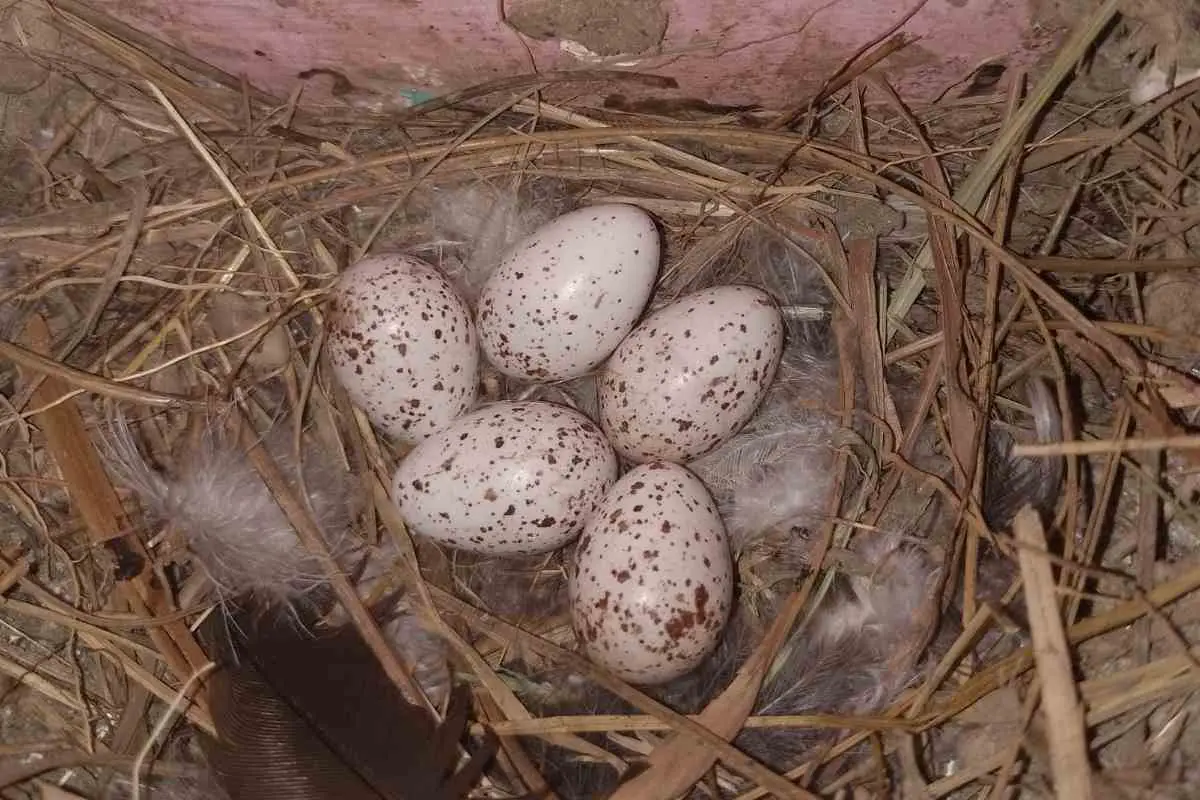Woodpeckers are a family of birds that find food by pecking tree trunks using their beaks. They have long, strong beaks that help them to fend for food.
Forests and woodlands are the primary habitats for woodpeckers. Most species eat insects, with others eating worms, berries, acorns, and nuts.
Like other birds, woodpeckers reproduce by laying eggs. Each female lays four to six eggs per cycle and incubates them for two weeks before hatching.
Read on to discover more about woodpecker eggs.
Courting and Mating
Mature woodpeckers initiate courting by swinging their heads, touching bills, and engaging in slow, exaggerated flights.
This later progresses into vocal exchanges in low tones and culminates in copulation. All these happen inside the nest.
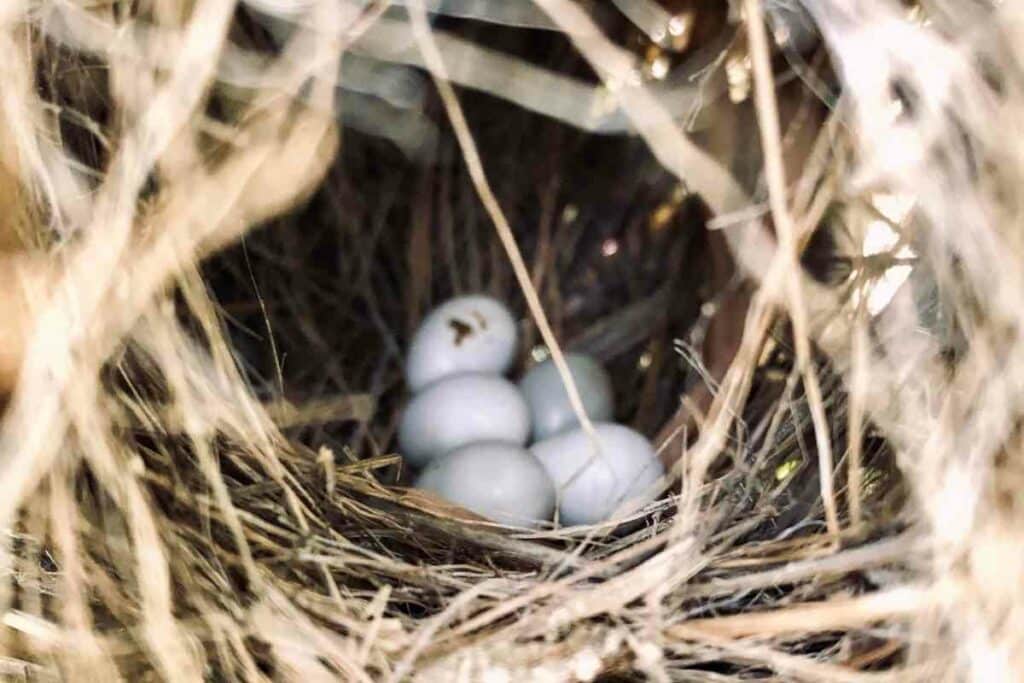
Both sexes attach to their sites by performing slow, repetitive drumming. Some species, such as red-bellied woodpeckers, drum concurrently.
Red-bellied and red-headed woodpeckers copulate in ‘reverse,’ in that the female mounts the male.
Before the Mating Season – Male and female birds dig holes in trees where they will incubate the fertilized eggs. The incubation period usually lasts an estimated 14 days.
Since woodpeckers are omnivores, they feed on vegetables, insects, and worms, like growing in riverine areas or near water bodies.
This explains why the birds mate close to ponds, rivers, and lakes.
Nesting
Woodpeckers form nests in tree cavities.
However, species that live in deserts nest inside cacti cavities, with a few digging holes into the ground.
These birds are specific when choosing a nest site – they look for holes slightly wider than their body width. The holes can have any shape.
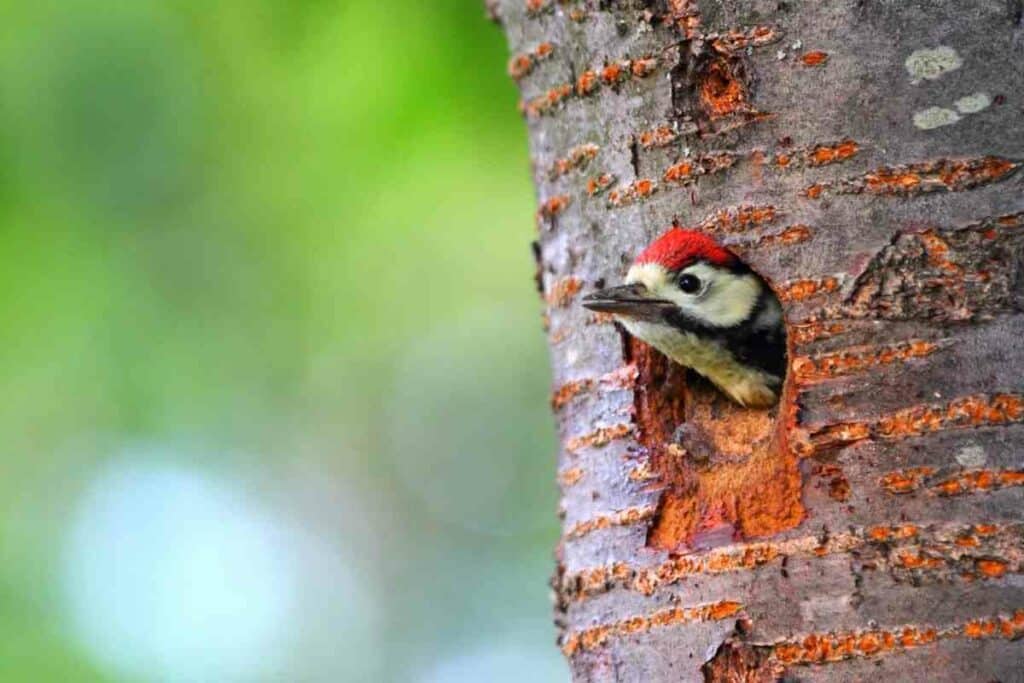
Sometimes, woodpeckers target dead trees with robust outer shells and soft interiors. Unfortunately, the cedar used on some homes fits these criteria.
Male woodpeckers usually bore tree trunks to create nests. The activity is interesting to watch, as the bird always seems to do it effortlessly.
After digging the cavity, the male bird uses wood chips as the nest’s lining.
In Most Cases – Woodpeckers create one nest per breeding season. But, sometimes, they can dig several holes before finding one that suits their needs.
The excavation process can take up to one month to complete, depending on the maturity of the target trees.
Generally, older trees are harder to dig because of the hardened trunk.
Once the breeding and incubation season is over, other birds and animals might use woodpeckers’ nests.
These creatures are called secondary cavity nesters. There’s often great competition for these nests among other woodpecker species, starlings, swallows, and rodents.
Woodpeckers employ defensive strategies to protect their nest sides against secondary cavity nesters. Although rare, they can become aggressive.
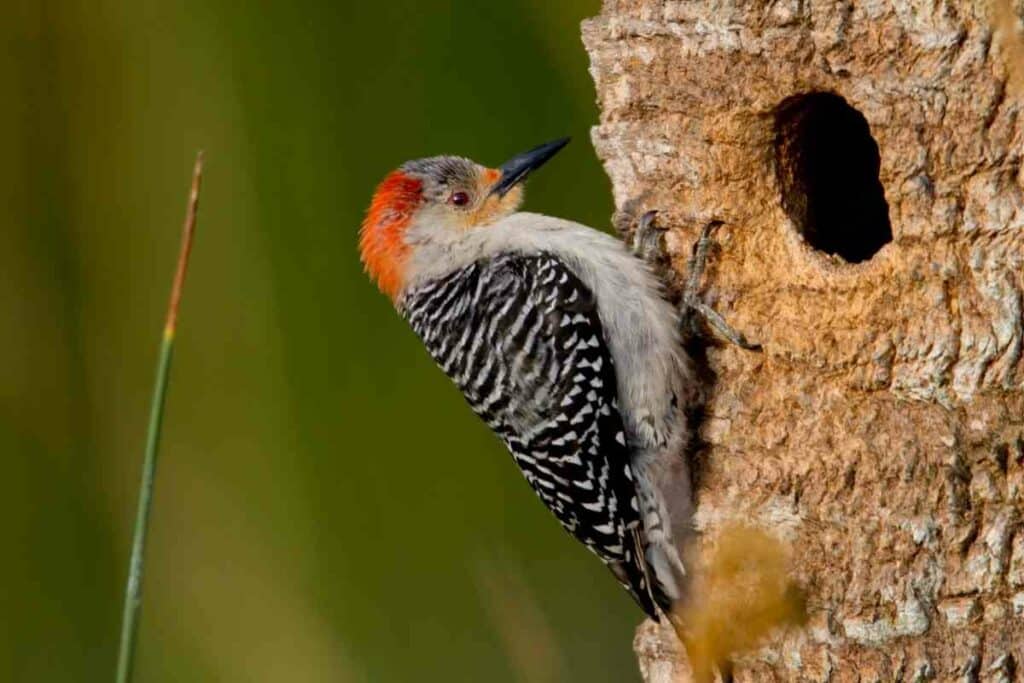
The red-crowned woodpecker is considerably brilliant at protecting its nest. Instead of the uninteresting tree trunk, it builds its nest on the underside of small branches, preventing larger animals from taking over.
Male woodpeckers are more resourceful to females than other bird species and they:
- excavate tree trunks
- build the nest
- incubate eggs
- and raise the offspring
After digging during the daytime, males incubate eggs at night to allow the females to rest.
Will Woodpeckers Use the Same Nest Each Year?
Most woodpecker species build a new nest every breeding season, while some reuse ones from the previous spring.
Unfortunately, old nests are usually messy – they contain rotten food, urine, feces, and eggshell fragments, making them unsuitable for raising young birds.
As Mentioned Earlier – It takes time to construct a new nest. For example, digging a cavity in the tree trunks takes three to six weeks, and making the interior suitable for incubation and nestling takes an extra four weeks.
For some woodpecker species, this is cumbersome.
Instead, Acorn and red-headed woodpeckers usually return to their old nests, clean them and reuse them for the subsequent breeding season.
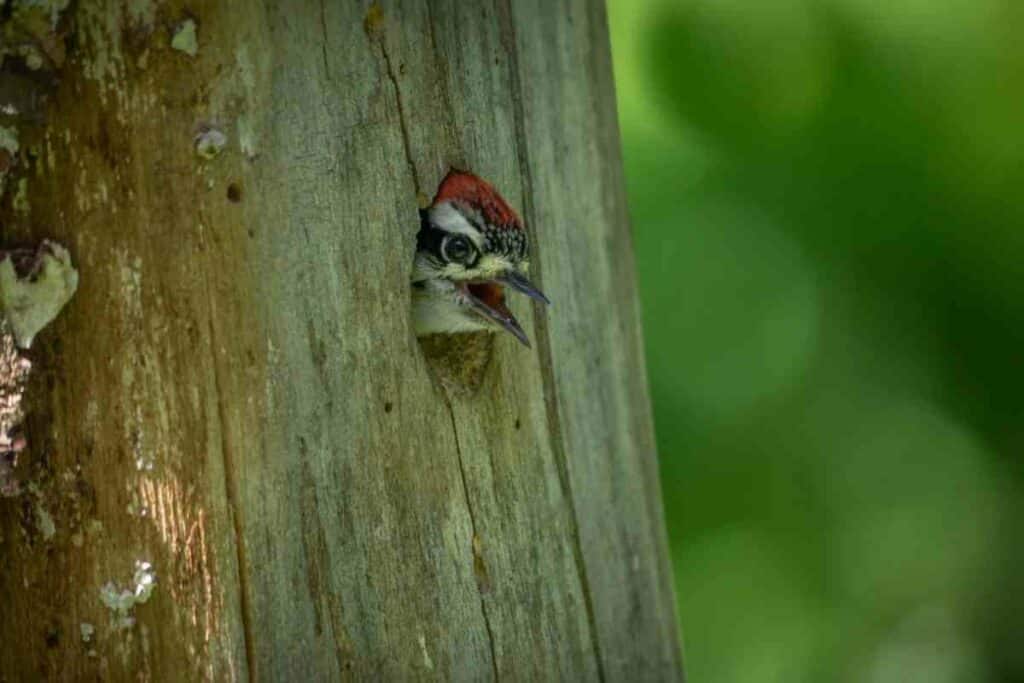
It’s worth noting that most species build new nests every spring. These species include downy woodpeckers, hairy woodpeckers, and pileated woodpeckers.
When Do Woodpeckers Start Laying Eggs?
Woodpeckers attain sexual maturity on their first birthday.
Most woodpecker species start laying eggs in spring through to summer. You can begin noticing woodpecker eggs from early April to the end of July.
However, egg-laying patterns can vary in different woodpecker species.
How Many Eggs Does a Woodpecker Lay?
The number of eggs a woodpecker lays depends on the woodpecker species.
On average, these birds lay four to six eggs, varying widely among species.
For instance, the green woodpecker lays five to seven eggs, while the pileated woodpecker lays three to five eggs.
Also, the downy woodpecker lays three to eight eggs, while the read-headed species produces between three and ten eggs.
Characteristics of Woodpecker Eggs
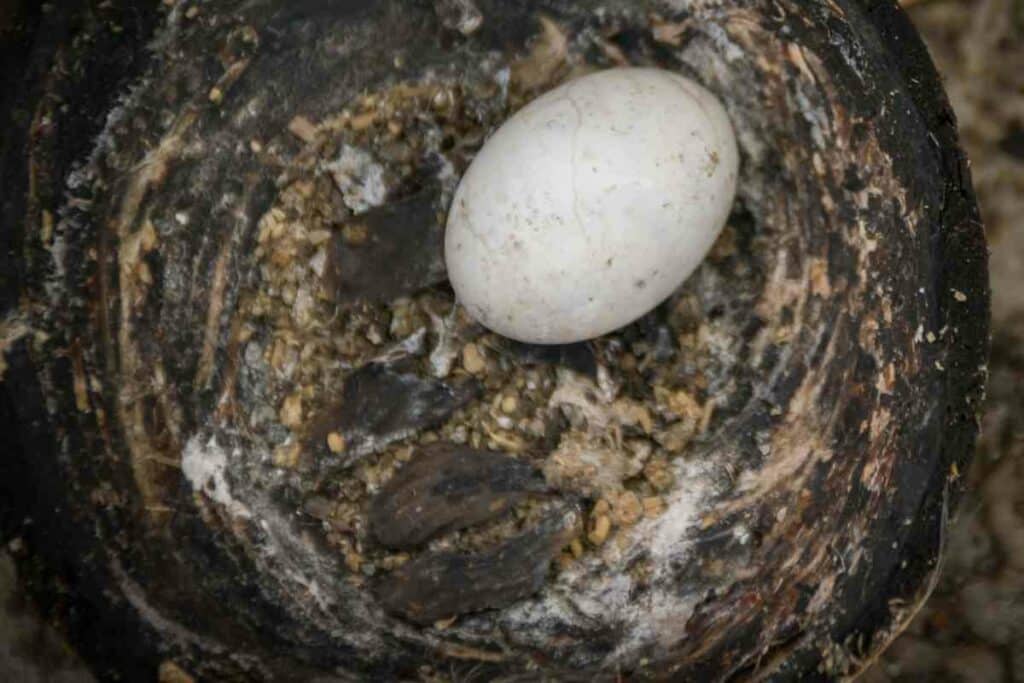
Here are the defining characteristics of woodpecker eggs.
Size
Generally, woodpeckers lay larger eggs.
For instance, the read-headed woodpecker lays eggs averaging 1″ in length and width.
Conversely, the pileated woodpecker lays much larger eggs, averaging 1.2″ in length and diameter.
Clutch Size
Woodpeckers have a clutch size of three to ten eggs.
A clutch refers to the number of eggs a bird can lay in a single session inside a nest.
The clutch size technique helps increase egg production and bird population.
Clutch size mostly depends on food availability in a habitat. They produce more eggs if the birds receive adequate feed during the mating and breeding seasons.
Number Of Broods
Brood is the number of eggs hatched at a specific time. Woodpeckers’ broods vary between one and two.
This is much lower than other bird species, whose numbers can go as high as fifteen.
Color
Most woodpeckers lay white eggs. While not all are pure white, they have different shades of color.
In rare instances, these birds can produce blue, cream, or grey eggs, some shiny and others with a matte finish.
Using color as the primary identification feature for woodpecker eggs isn’t advisable, as it isn’t consistent across all species.
Instead, when you see an egg, prioritize its size over color to know if it’s a woodpecker’s.
Incubation and Nestling Period
The incubation period for woodpeckers lasts between 12 and 14 days.
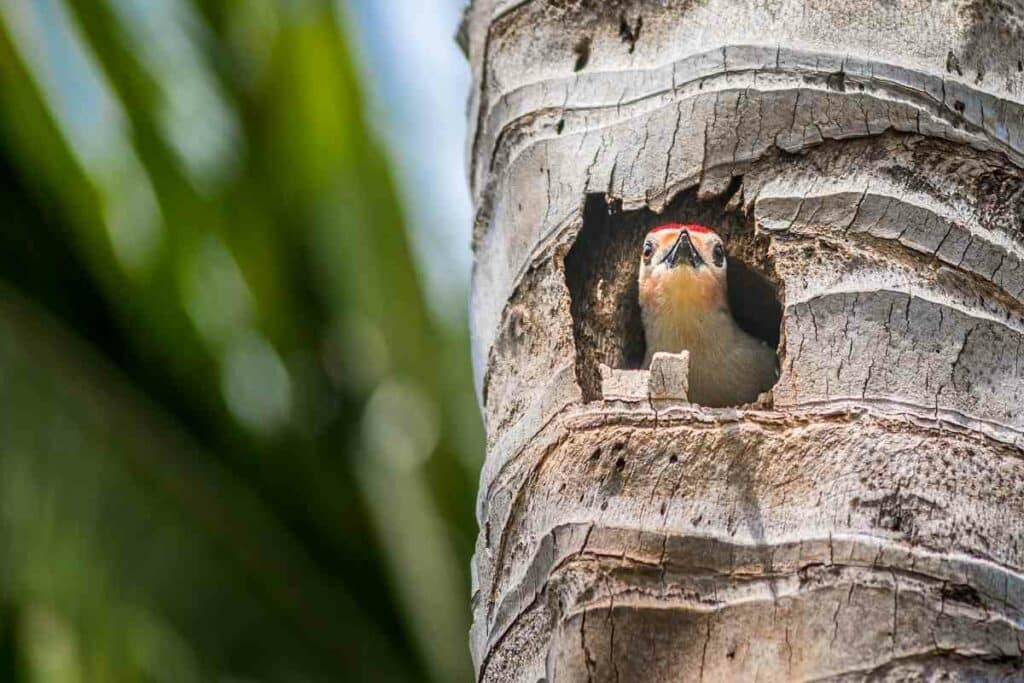
After that, both parents guard the eggs for 30 to 50-minute intervals, taking turns during this time. Then, the free parent looks for food as the other watches the eggs.
Like most birds, woodpecker eggs need warmth to hatch. (up to 100oF)
To ensure the eggs receive an even temperature during incubation, woodpeckers turn them over periodically.
When the eggs hatch, blind and featherless young ones emerge. The birds remain ‘blind’ for 10 to 12 days, after which the eyes open.
Woodpeckers nestle their young ones for 18 to 35 days. Once the feathers emerge, the birds leave the nest, searching for food and new territories.
However, these little birds often return to spend time with their parents for up to two months before finding new homes.
Does the Female Woodpecker Always Hatch Eggs?
Female birds don’t always hatch eggs.
Sometimes, they leave the eggs and tend to their offspring.
As mentioned earlier, male woodpeckers are resourceful, taking care of the eggs as the mother looks after her children.
However, such behavior isn’t typical, with only 20% of birds taking turns incubating eggs.
Woodpeckers are monogamous and will mostly stick to one mate their entire lives.
Of course, some species are exceptions, but those who find a suitable mate tend to reduce aggressive behavior.
FAQs About Woodpeckers
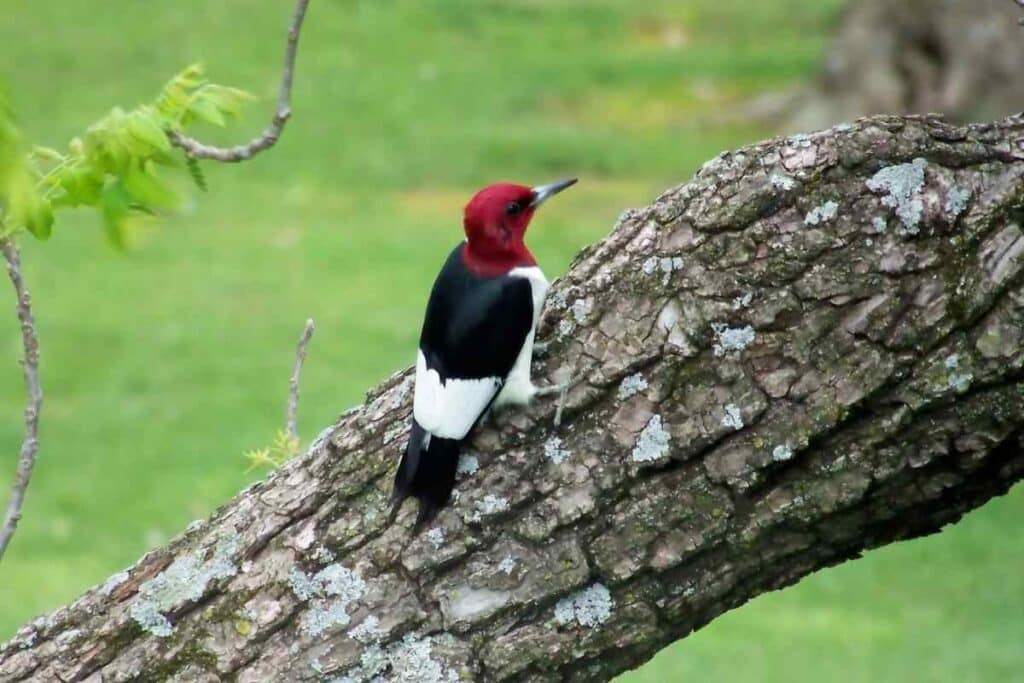
1. What season do woodpeckers mate?
Woodpeckers mate in spring, between April and May. During this period, tree drumming intensifies as birds seek potential mates. The sounds are also used to mark territory.
2. What season do woodpeckers come out?
Nesting coincides with the breeding season, which falls between April and May. Therefore, if your home has many woodpeckers, eliminate them before this period.
3. Why does the male woodpecker feed the female?
Male woodpeckers are naturally resourceful. They build nests, incubate eggs, care for young ones, and provide food. In some species, such as the downy woodpecker, feeding is crucial to bonding.
4. How many eggs do woodpeckers lay?
The average number of eggs laid by woodpeckers is four to six. However, this varies in different species. The rule of thumb states that smaller birds lay more eggs than larger ones. However, the latter produce larger eggs.
5. How often do woodpeckers lay eggs?
Woodpeckers become sexually viable after their first birthday. After this, they start matting, producing one to two eggs in every brood. Depending on the species, a bird can lay up to ten eggs in one breeding season.
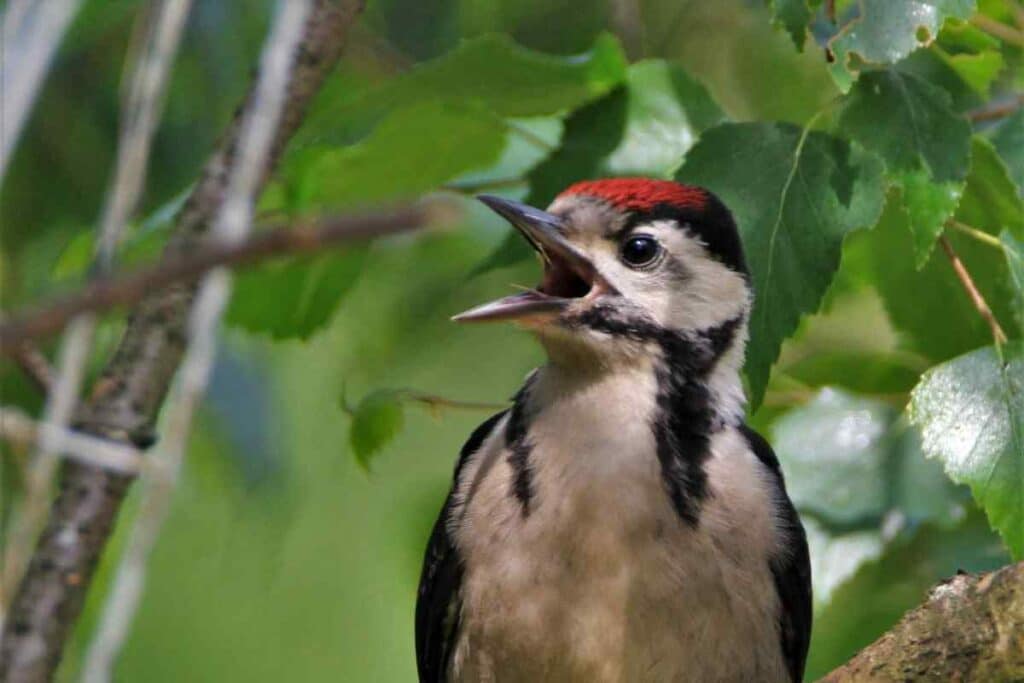
Final Words
Woodpeckers are an interesting bird species.
They are visually stunning and can help in dealing with worms and insects. However, some species target your fruits and vegetables, causing significant damage.
Like most avian species, woodpeckers mate and lay eggs in spring. After this, they incubate for two weeks and tend to young ones for a month before releasing them into the wild.
However, the fascinating thing about these birds is the resourcefulness of males. Unlike others who take a laid-back approach, they are involved in every step, from mating to hatching!
